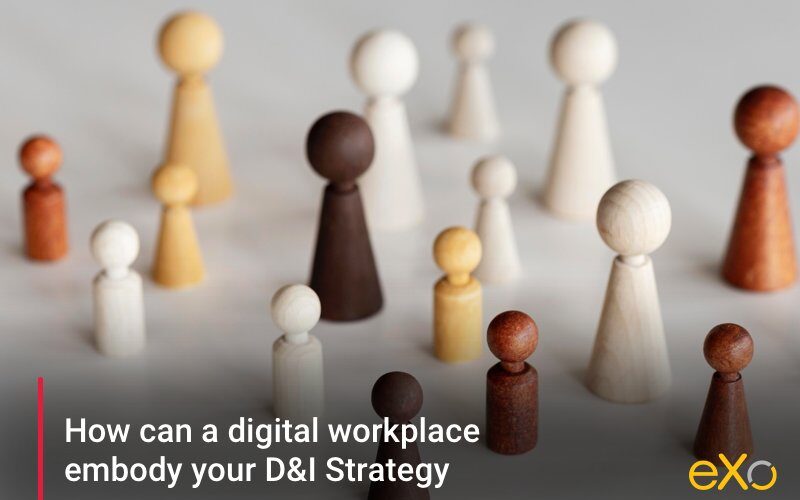- Fares Laroui
- August 18, 2021
How can a digital workplace embody your D&I Strategy
The topics of diversity, equality and inclusion whether within the society at large or within a working environment have always been sensitive to say the least. Throughout the years, governments, businesses, societies and communities have always been trying to promote diversification and stand up to any forms of inequality whether based on race, gender, sexuality, religion, etc.

Content
However, it is safe to say that despite these best efforts, there is still a long road to reach an equal society where everyone has equal rights and is treated the same. This has been directly reflected within the recent movements we have witnessed in the last couple of years where protestants have been asking for equal opportunities both in their personal and working lives.
The changing dynamics in today’s workplace due to the emergence of younger generations (millennials and Gen Z) have ingrained diversity and inclusion (D&I) at the core of any business.
On the one hand, a host of businesses have started to pledge their support for diversification and promised drastic measures to ensure their workplaces are more diverse and inclusive. On the other hand, both job seekers and employees alike are keeping a watchful eye to ensure businesses are true to their word.
Within this current climate of change and awakening, it is a no-brainer that developing a D&I strategy is the right thing for businesses from, of course, a moral and ethical point of view as well as a business point of view.
In this blog post, we are going to shed light on the importance of diversity in the workplace and examine how digital workplace solutions can help in promoting and developing more inclusive working environments.
1. What are the benefits of diversification in the workplace?
Foster collaboration and increase productivity
It goes without saying that the key for a successful workplace is people who can effectively collaborate and mount challenges together.
As previously mentioned, the surge of new generations in the workplace has meant that businesses need to rapidly adapt to their growing demands and expectations.
Contrary to previous generations who are mostly driven by money and equity, Millennials and Gen Z want to find meaning in their work and be part of an inclusive and transparent culture that favors innovation, teamwork and collaboration. And diversity plays an important role in this. According to multiple research studies, diverse teams are extremely productive. Assembling teams from different backgrounds, cultures and genders often drives innovation, widens perspectives and facilitates problem solving. Additionally, team members can continuously learn from each other’s experiences and expertise which can only be beneficial both for the individual and the group as a whole.

FREE WHITE PAPER
Types of Digital workplace solutions
The modern workplace has evolved significantly in recent years, with advancements in technology, the growing number of tools …
Engage the workforce
Employee engagement is by far the most recurrent challenge facing businesses today especially when dealing with the young emerging generations. According to a Gallup report titled “How Millennials Want to Work and Live.”, millennials are the least engaged segment in the workplace, with only 29% feeling engaged, 55% admitting they are disengaged and 16% reporting they feel actively disengaged.
Although there are a variety of factors that influence engagement at work, lack of diversity is among the most persistent and rightly so. As previously stated, most of the workforce today perceive work differently. They value personal fulfillment and growth and would like to work for companies that can grant them a clear purpose, a career path and above all, equal opportunities.
Research shows that within transparent working environments, diversity practices and employee engagement go hand in hand. The more diverse the workplace, the more employees are engaged and vice versa.
The general misconception though is that only minorities would benefit from the implementation of diversity practices. The truth is that, at least according to the same research findings, all employees would benefit from a diverse and inclusive workplace. The reason being is that such an environment lays the foundation for all employees to benefit from each other and thrive to achieve their individual and team goals.
Attract and retain talents
The process of recruiting and retaining the best talents is a tedious one. Businesses should meet a wide array of criteria to gain a competitive edge, attract and keep hold of employees.
As mentioned earlier, employees nowadays are extremely demanding when it comes to selecting a job. Businesses who fail to comply with these demands can miss out on huge opportunities and find themselves trailing their competition.
There are multiple research studies that suggest diversity is of extreme importance for younger generations who consider it as a decisive criterion when selecting their future employers . For instance, according to a Glassdor report, 3 out of 4 job seekers or roughly 76% consider diversification as an important factor when evaluating job offers. Furthermore, 32% of respondents stated that they wouldn’t apply for a job at companies that lack diversity .
Gain a competitive advantage and generate more revenue growth
Another key business area that diversity and inclusion have the potential to improve is business growth. It has been proven by multiple research studies that businesses with a diverse workforce (whether in terms of race, gender, religion, etc) are market leaders as they have the human capital to continuously innovate, outperform their competitors, and especially, adapt to a variety of markets.
According to a study by the Boston Consulting Group (BCG), companies with a diverse leadership team registered 19% higher revenue growth due mainly to increased innovation and creativity within their ranks. Additionally, another study by “Great Place To Work” compared revenue growth between companies based on racial diversity. The study found that the companies with the largest gap between white employees and minorities had lower revenue growth compared to companies with the smallest gap.
2. How can a digital workplace assist in making the working environment more diverse and inclusive?
Promote transparency and streamline communications
Arguably the most important criterion that will help businesses engage their workforce and get everyone on board is transparency. Regardless of their best efforts, businesses are always at the mercy of their employees’ perceptions about these efforts. And the best way to guarantee employees perceive their work positively is by being transparent.
Digital workplace solutions are very effective tools that can help businesses of all sizes from a small online shop to a multi-vendor marketplace platform to create and promote a culture of trust and transparency in the workplace. Through advanced content management features, higher leaders and executives can convey their corporate culture along with important policies and updates through a series of news, articles, live broadcasts, or any other form of engaging and informative content.
Additionally, in the context of diversity and inclusion, business leaders shouldn’t shy away from sharing any progress that they might have made in terms of diversity, inclusion and recruitment strategies. This way, employees are well aware of their companies’ good intentions which obviously helps in building long lasting relationships based on trust.
Give employees a voice
Contrary to corporate intranets, digital workplace solutions often come equipped with a host of social features that can facilitate all types of internal communications (Top-down, bottom-up and peer-to-peer).
These features make it easy for both employers and employees to engage in fruitful discussions about a variety of topics, especially sensitive ones such as race, gender, etc. On the one hand, this has the potential to create a workplace culture where both parties can openly (and at times anonymously) voice their opinions and concerns about these topics through dedicated spaces or forums. On the other hand, employers can always stay up to date with these concerns through surveys and act accordingly.
Accessibility
Another way businesses can ensure diversity and inclusion in the workplace is by providing equal opportunities for individuals with disabilities. Although statistics indicate that there is still a disparity in terms of employment between people with and without disabilities, a growing number of businesses are starting to adapt their technologies to be used by everyone. This is known as software or web accessibility. In short, this term refers to making technology accessible for people with disabilities regardless of the nature and severity of the latter (learning disabilities or dyslexia, visual or hearing impairments, among others).
Digital workplace solutions that are compliant with different accessibility standards and guidelines (such as WCAG, ATAG, RGAA, …) are extremely effective in providing equal opportunities and making life easier for all employees.
For example, employees with visual impairments can easily navigate their digital workplace, locate, access and create content (such as articles, documents, wikis, etc) as well as read messages and interact with their peers.
Break down language barriers
One of the most recurrent requests we often receive from prospects is often related to the available languages and translation services within the digital workplace.
Many businesses have a diverse workforce and offices spread across the world. It makes sense to have a platform in place that can be configurable based on employees preferred language. This will help in eliminating communications barriers and creating a diverse workforce.
Diversity, equity and inclusion (DEI) are extremely sensitive topics in today’s modern workplace. Businesses have the responsibility to act morally and ethically to provide equal opportunities for their employees and guarantee their wellbeing.
Digital workplace solutions play an important role to help businesses achieve their diversity objectives as they act as the main medium capable of unifying employees and helping businesses effectively lay down and convey their D&I strategies.
A Digital Workplace tailored to your needs
Discover How To Boost your employee
engagement and performance
engagement and performance
FAQ
You will find here Frequently Asked Questions about digital workplace with all the answers in one place.
What is a digital workplace?
A digital workplace is a next generation of intranet solutions or intranet 2.0 that is based on three pillars: communication, collaboration and information. In a way this definition is true but it doesn’t cover the whole spectrum of the term.
Here are some definitions of digital workplace:
- An evolution of the intranet
- A user centric digital experience
What are the benefits of diversification in the workplace?
Here are some benefits of diversification in the workplace:
- Foster collaboration and increase productivity
- Engage the workforce
- Attract and retain talents
- Gain a competitive advantage and generate more revenue growth
➝ Find out some benefits of diversification in the workplace
How can a digital workplace assist in making the working environment more diverse and inclusive?
How digital workplace solutions can help in promoting and developing more inclusive working environments:
- Promote transparency and streamline communications
- Give employees a voice
- Accessibility
- Break down language barriers
How to launch an effective Digital Workplace?
- Understand users’ needs
- Identify your digital workplace ambassadors
- Build the digital workplace brand
- Training and onboarding
- Plan the big day
What does digital workplace really mean?
The digital workplace is the virtual, digital equivalent of the physical workplace. It is a holistic user-centered solution used to connect, engage, and empower employees. Through an employee-centered hub, it encompasses a set of tools, applications, and platforms for a complete work experience. ➝ Find out some definitions of the digital workplace
How to be a good digital workplace manager?
- Analytical skills and approach
- Focus on employees
- Communication and strategic vision
4.9/5 - (84 votes)
I am a product marketing specialist at eXo. My role is to assist marketing and sales teams in their operations and present our digital workplace solution to the world. I mainly blog about the latest tech trends, digital transformation, internal communication and how to navigate through eXo Platform.
Related posts
- All
- eXo
- Digital workplace
- Employee engagement
- Open source
- Future of work
- Internal communication
- Collaboration
- News
- intranet
- workplace
- Knowledge management
- Employee experience
- Employee productivity
- onboarding
- Employee recognition
- Change management
- Cartoon
- Digital transformation
- Infographic
- Remote work
- Industry trends
- Product News
- Thought leadership
- Tips & Tricks
- Tutorial
- Uncategorized
Leave a Reply
( Your e-mail address will not be published)
Connexion
0 Comments
Commentaires en ligne
Afficher tous les commentaires


